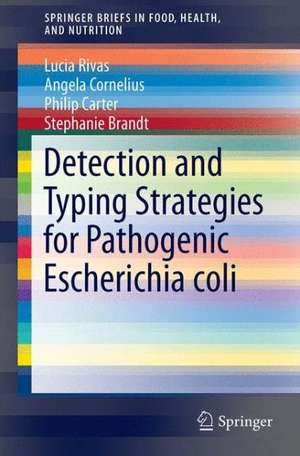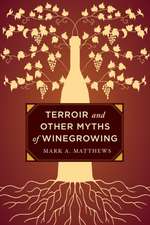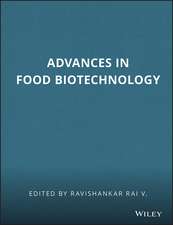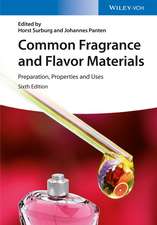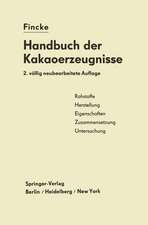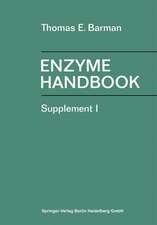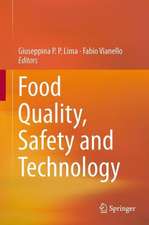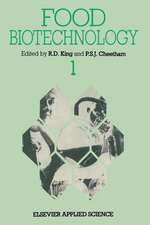Detection and Typing Strategies for Pathogenic Escherichia coli: SpringerBriefs in Food, Health, and Nutrition
Autor Lucia Rivas, Glen E. Mellor, Kari Gobius, Narelle Feganen Limba Engleză Paperback – 29 ian 2015
Din seria SpringerBriefs in Food, Health, and Nutrition
-
 Preț: 378.12 lei
Preț: 378.12 lei -
 Preț: 381.00 lei
Preț: 381.00 lei -
 Preț: 408.82 lei
Preț: 408.82 lei -
 Preț: 380.07 lei
Preț: 380.07 lei -
 Preț: 381.00 lei
Preț: 381.00 lei -
 Preț: 471.95 lei
Preț: 471.95 lei -
 Preț: 377.18 lei
Preț: 377.18 lei -
 Preț: 379.09 lei
Preț: 379.09 lei -
 Preț: 379.09 lei
Preț: 379.09 lei -
 Preț: 374.46 lei
Preț: 374.46 lei -
 Preț: 374.46 lei
Preț: 374.46 lei -
 Preț: 377.18 lei
Preț: 377.18 lei -
 Preț: 375.45 lei
Preț: 375.45 lei -
 Preț: 374.85 lei
Preț: 374.85 lei -
 Preț: 377.18 lei
Preț: 377.18 lei - 20%
 Preț: 322.50 lei
Preț: 322.50 lei -
 Preț: 374.08 lei
Preț: 374.08 lei -
 Preț: 376.80 lei
Preț: 376.80 lei -
 Preț: 348.40 lei
Preț: 348.40 lei -
 Preț: 380.84 lei
Preț: 380.84 lei -
 Preț: 376.80 lei
Preț: 376.80 lei -
 Preț: 378.34 lei
Preț: 378.34 lei -
 Preț: 382.95 lei
Preț: 382.95 lei -
 Preț: 374.08 lei
Preț: 374.08 lei -
 Preț: 377.35 lei
Preț: 377.35 lei -
 Preț: 374.85 lei
Preț: 374.85 lei -
 Preț: 375.84 lei
Preț: 375.84 lei -
 Preț: 376.04 lei
Preț: 376.04 lei -
 Preț: 377.18 lei
Preț: 377.18 lei -
 Preț: 375.62 lei
Preț: 375.62 lei -
 Preț: 411.32 lei
Preț: 411.32 lei -
 Preț: 379.86 lei
Preț: 379.86 lei -
 Preț: 379.30 lei
Preț: 379.30 lei -
 Preț: 376.96 lei
Preț: 376.96 lei -
 Preț: 352.58 lei
Preț: 352.58 lei -
 Preț: 352.97 lei
Preț: 352.97 lei -
 Preț: 380.25 lei
Preț: 380.25 lei -
 Preț: 373.54 lei
Preț: 373.54 lei -
 Preț: 343.00 lei
Preț: 343.00 lei -
 Preț: 375.45 lei
Preț: 375.45 lei -
 Preț: 375.23 lei
Preț: 375.23 lei -
 Preț: 412.30 lei
Preț: 412.30 lei
Preț: 377.95 lei
Nou
Puncte Express: 567
Preț estimativ în valută:
72.32€ • 75.51$ • 59.85£
72.32€ • 75.51$ • 59.85£
Carte tipărită la comandă
Livrare economică 05-19 aprilie
Preluare comenzi: 021 569.72.76
Specificații
ISBN-13: 9781493923458
ISBN-10: 1493923455
Pagini: 116
Ilustrații: VI, 110 p. 6 illus., 5 illus. in color.
Dimensiuni: 155 x 235 x 6 mm
Greutate: 0.18 kg
Ediția:2015
Editura: Springer
Colecția Springer
Seria SpringerBriefs in Food, Health, and Nutrition
Locul publicării:New York, NY, United States
ISBN-10: 1493923455
Pagini: 116
Ilustrații: VI, 110 p. 6 illus., 5 illus. in color.
Dimensiuni: 155 x 235 x 6 mm
Greutate: 0.18 kg
Ediția:2015
Editura: Springer
Colecția Springer
Seria SpringerBriefs in Food, Health, and Nutrition
Locul publicării:New York, NY, United States
Public țintă
ResearchCuprins
Chapter 1 Introduction to Pathogenic Escherichia coli.- 1.1 Pathotypes of Escherichia coli causing diarrhoeal diseases.- 1.2 Escherichia coli.- 1.3 Pathogenic types of E. coli.- 1.4 Shiga toxin-producing and Enterohemorrhagic E. coli.- 1.4.1 Virulence determinants of Shiga-toxin producing E. coli.- 1.4.2 Shiga-toxin producing E. coli-mediated disease.- 1.4.3 Epidemiology of Shiga toxin-producing E. coli.- 1.4.4 Ecology of Shiga-toxin producing E. coli.- 1.4.5 Transmission of Shiga-toxin producing E. coli.- 1.4.6 Shiga-toxin producing E. coli occurrence in foods.- 1.5 Enterotoxigenic E. coli.- 1.6 Enteropathogenic E. coli.- 1.7 Enteroinvasive E. coli.- 1.8 Enteroaggregative and Diffusely Adherent E. coli..-1.9 References.- Chapter 2 Isolation and detection of pathogenic Escherichia coli in foods.- 2.1 Introduction.- 2.2 General method of isolation for E. coli.- 2.3 Shiga toxin-producing E. coli.- 2.3.1 Culture and isolation of Shiga toxin-producing E. coli.- 2.3.2 Molecular detection of Shiga toxin-producing E. coli.- 2.4 Enumeration of Shiga toxin-producing E.coli.- 2.5 Immunological detection methods for pathogenic E. coli.- 2.6 Cell culture assays used for pathogenic E. coli.- 2.6.1 Cell cytotoxicity assay for Shiga toxin-producing E. coli.- 2.6.2 Cell adherence assays.- 2.7 Enteroinvasive E. coli.- 2.8 Enterotoxigenic E. coli.- 2.9 Enteropathogenic E. coli.- 2.10 Enteroaggregative E. coli and Diffusely Adherent E. coli.- 2.11 References.- Chapter 3 Typing and Subtyping methods for pathogenic Escherichia coli.- 3.1 Introduction.- 3.2 Biochemical profiling.- 3.3 Serotyping.- 3.4 Phage typing.- 3.5 Multilocus enzyme electrophoresis.- 3.6 Multilocus sequencetyping.- 3.7 Pulsed-field gel electrophoresis.- 3.8 Multiple-locus variable number tandem repeat analysis.- 3.9 Repetitive element palindromic polymerase chain reaction.- 3.10 Random amplified polymorphic DNA.- 3.11 Shiga toxin subtypes and bacteriophage insertion sites.- 3.12 Lineage specific polymorphism analysis.- 3.13 Whole genome sequencing.- 3.14.- References.- Chapter 4 Emerging and future trends and technologies for the detection and typing of Escherichia coli.- 4.1 Future trends in foodborne illness and E. coli.- 4.2 Future trends in the detection and typing of pathogens.- 4.2.1 Microarrays.- 4.2.2 Matrix Assisted Laser-Desorption Ionization-Time-Of-Flight Mass Spectrometry.- 4.2.3 Nanotechnology.- 4.2.4 Next-generating sequencing of the whole bacterial genome.- 4.3 References
Caracteristici
Includes supplementary material: sn.pub/extras
